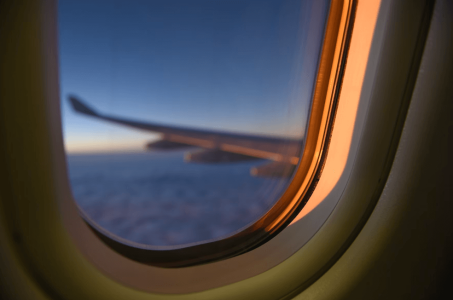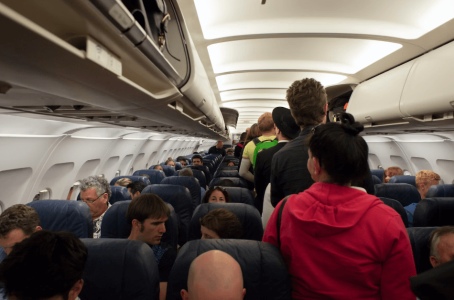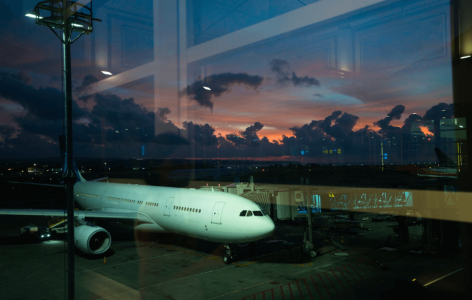Cabin Safety 101: How to Stay Safe and Secure on Your Next Flight
- Replies 1
Looking to have a stress-free and safe travel experience? Look no further because we have got you covered!
Air travel can be a bit daunting for some, but don’t worry; there are some insider tips you can follow to make your journey not only more secure but also more enjoyable.
And who better to give us the inside scoop than a commercial pilot with ten years of experience, working for one of the largest carriers in the world? Get ready to take notes because we are about to reveal some aeroplane safety tips straight from the expert himself.

The right kind of footwear
When it comes to air travel, footwear is more important than you may think. While it's tempting to dress up and look your best, choosing the right shoes can make all the difference in ensuring your safety and comfort during the flight.
Instead of reaching for those heels or fancy shoes, opt for something more practical and comfortable. You never know when you might need to move quickly in case of an emergency, and uncomfortable or restrictive footwear can impede your movements and put you at risk.
For your own safety and peace of mind, choose closed-toe shoes that provide adequate support and protection. You'll also want to avoid thongs or sandals, which offer little to no protection from germs and potential hazards on the plane floor.
Familiarise yourself with the brace position
The brace position: a simple yet potentially life-saving technique that every air traveller should be familiar with. Despite rumours to the contrary, the brace position is not intended to harm passengers, but rather to protect them during a collision, as explained by the experts from the Federal Aviation Administration (FAA) in the United States.
In the event of an impact, assuming the brace position can significantly reduce the impact on your body and increase your chances of survival. It's a small but crucial step that can make a big difference in an emergency situation.
It's never too late to learn or practise the brace position, even if you're a frequent flyer. Familiarise yourself with the FAA's guidelines and be prepared to follow them if needed. It's a motor skill that could save your life, and the peace of mind that comes with being prepared is invaluable when it comes to air travel.
Don't underestimate the importance of the brace position, and make sure you know how to do it effectively. Your safety is worth it.
Credit: BBC Earth Lab.
Seats towards the back of the plane are the safest
Are you concerned about your safety while flying? Consider booking a seat towards the back of the plane for added peace of mind. Studies have shown that seats in the back two-thirds of the aircraft tend to be safer in the event of an emergency.
Why is this the case? The back of the plane is typically the strongest section of the aircraft, and the chances of survival are higher from there. In the event of a crash or collision, the back of the plane may be more protected and less affected by the impact.
Rely on your seatbelt
Turbulence is an inevitable part of air travel, and it's important to take the necessary precautions to protect yourself. One of the most important steps you can take is to always fasten your seatbelt during turbulence - ideally before it even starts.
In the event of severe turbulence, failing to wear a securely fastened seat belt can lead to serious injuries. People have been known to hit their heads on the ceiling of the plane, which can cause painful injuries due to the lights and air conditioning ports. Loose items can also become dangerous projectiles and cause major injuries.
Be aware of items in overhead bins
Speaking of turbulence, when you're travelling by air, it's important to be mindful of what you store in the overhead bins. While it can be tempting to cram as much as possible into these limited spaces, doing so can pose a risk to yourself and your fellow passengers.
Loose items in the overhead bins can become dangerous projectiles during turbulence or in the event of an impact, potentially causing serious injuries. It's crucial to make sure that anything you store in the overhead bin is well-secured and won't move around during the flight.

Be mindful of your alcohol consumption
While some travellers may find it tempting to indulge in alcohol during a flight, it's important to be mindful of your consumption or avoid it altogether. Due to the lower oxygen levels in the cabin, you can become drunk much faster than you would on the ground.
If you do choose to have alcohol, it's important to pace yourself and stay hydrated. Make sure to have a glass of water for every alcohol drink you consume, which can help mitigate the dehydrating effects of the plane's low humidity and keep you sober throughout the flight.
Alternatively, if you're concerned about the effects of alcohol in the air, it may be best to avoid drinking altogether. This can help you stay alert, focused, and comfortable throughout your flight.
Be careful of the toilet cubicle
The aeroplane toilet can be a germ hotspot, so it's important to take extra precautions if you need to use it. Consider bringing a pair of ‘indoor shoes’ to avoid touching any surfaces with your bare feet.
Remember to wash your hands thoroughly with soap and water after using the toilet to prevent the spread of germs. You can also use a hand sanitiser with at least 60% alcohol content if soap and water are not available.
Additionally, be aware that the inside of the toilet cubicle can be hazardous during turbulence, as sharp edges, countertops, and shelves could become potential safety hazards. If possible, it's best to avoid using the restroom during turbulent weather.

Keep the galley area off-limits
Keep in mind that the galley area of the plane is the crew's workspace, and it may contain potentially dangerous objects such as knives, glass bottles, and more. Therefore, it's best to avoid this area during the flight, especially during more turbulent conditions.
Boiling water, hot drinks, and hot meals are frequently prepared here, and these items may present a risk of scalding. If you need assistance from the flight crew, use the call button above your seat to request their help. They are trained to handle any situation and will be more than happy to assist you.
Lightning isn't usually dangerous
We know that seeing lightning strikes while you're on a plane can be pretty scary. But don't worry too much! Most of the time, planes are built to handle it. While the exterior of the plane might take a beating, lightning strikes usually only require a quick check-up on the ground before the plane can take off again.
That being said, planes made from carbon fibres — such as one of those modern aircraft composites — are a different story; lightning strikes could actually cause some serious damage!

Air travel can be a bit daunting, but with these tips, you can be more confident and prepared for your next flight. Remember to wear the right shoes, keep your seatbelt fastened during turbulence, and avoid excessive alcohol consumption or using the galley area.
Pay attention to your surroundings, be cautious of germs, and keep loose items in check. With all of these in mind, you'll be flying like a pro in no time!
Members, what do you think? Have you experienced any other safety concerns during air travel? Do you have any additional tips to share? Let us know in the comments below!
Air travel can be a bit daunting for some, but don’t worry; there are some insider tips you can follow to make your journey not only more secure but also more enjoyable.
And who better to give us the inside scoop than a commercial pilot with ten years of experience, working for one of the largest carriers in the world? Get ready to take notes because we are about to reveal some aeroplane safety tips straight from the expert himself.

A commercial pilot reveals some life-saving tips every passenger should know to stay safe in the air. Credit: Unsplash/Suhyeon Choi.
The right kind of footwear
When it comes to air travel, footwear is more important than you may think. While it's tempting to dress up and look your best, choosing the right shoes can make all the difference in ensuring your safety and comfort during the flight.
Instead of reaching for those heels or fancy shoes, opt for something more practical and comfortable. You never know when you might need to move quickly in case of an emergency, and uncomfortable or restrictive footwear can impede your movements and put you at risk.
For your own safety and peace of mind, choose closed-toe shoes that provide adequate support and protection. You'll also want to avoid thongs or sandals, which offer little to no protection from germs and potential hazards on the plane floor.
Familiarise yourself with the brace position
The brace position: a simple yet potentially life-saving technique that every air traveller should be familiar with. Despite rumours to the contrary, the brace position is not intended to harm passengers, but rather to protect them during a collision, as explained by the experts from the Federal Aviation Administration (FAA) in the United States.
In the event of an impact, assuming the brace position can significantly reduce the impact on your body and increase your chances of survival. It's a small but crucial step that can make a big difference in an emergency situation.
It's never too late to learn or practise the brace position, even if you're a frequent flyer. Familiarise yourself with the FAA's guidelines and be prepared to follow them if needed. It's a motor skill that could save your life, and the peace of mind that comes with being prepared is invaluable when it comes to air travel.
Don't underestimate the importance of the brace position, and make sure you know how to do it effectively. Your safety is worth it.
Credit: BBC Earth Lab.
Seats towards the back of the plane are the safest
Are you concerned about your safety while flying? Consider booking a seat towards the back of the plane for added peace of mind. Studies have shown that seats in the back two-thirds of the aircraft tend to be safer in the event of an emergency.
Why is this the case? The back of the plane is typically the strongest section of the aircraft, and the chances of survival are higher from there. In the event of a crash or collision, the back of the plane may be more protected and less affected by the impact.
Rely on your seatbelt
Turbulence is an inevitable part of air travel, and it's important to take the necessary precautions to protect yourself. One of the most important steps you can take is to always fasten your seatbelt during turbulence - ideally before it even starts.
In the event of severe turbulence, failing to wear a securely fastened seat belt can lead to serious injuries. People have been known to hit their heads on the ceiling of the plane, which can cause painful injuries due to the lights and air conditioning ports. Loose items can also become dangerous projectiles and cause major injuries.
Be aware of items in overhead bins
Speaking of turbulence, when you're travelling by air, it's important to be mindful of what you store in the overhead bins. While it can be tempting to cram as much as possible into these limited spaces, doing so can pose a risk to yourself and your fellow passengers.
Loose items in the overhead bins can become dangerous projectiles during turbulence or in the event of an impact, potentially causing serious injuries. It's crucial to make sure that anything you store in the overhead bin is well-secured and won't move around during the flight.

Avoid squeezing bags in spaces, as they will come flying out if the bin pops open, and this sometimes happens on landing. Credit: Unsplash/Chris Brignola.
Be mindful of your alcohol consumption
While some travellers may find it tempting to indulge in alcohol during a flight, it's important to be mindful of your consumption or avoid it altogether. Due to the lower oxygen levels in the cabin, you can become drunk much faster than you would on the ground.
If you do choose to have alcohol, it's important to pace yourself and stay hydrated. Make sure to have a glass of water for every alcohol drink you consume, which can help mitigate the dehydrating effects of the plane's low humidity and keep you sober throughout the flight.
Alternatively, if you're concerned about the effects of alcohol in the air, it may be best to avoid drinking altogether. This can help you stay alert, focused, and comfortable throughout your flight.
Be careful of the toilet cubicle
The aeroplane toilet can be a germ hotspot, so it's important to take extra precautions if you need to use it. Consider bringing a pair of ‘indoor shoes’ to avoid touching any surfaces with your bare feet.
Remember to wash your hands thoroughly with soap and water after using the toilet to prevent the spread of germs. You can also use a hand sanitiser with at least 60% alcohol content if soap and water are not available.
Additionally, be aware that the inside of the toilet cubicle can be hazardous during turbulence, as sharp edges, countertops, and shelves could become potential safety hazards. If possible, it's best to avoid using the restroom during turbulent weather.

Seeing lightning strike through the plane during flight can be a frightening sight – but the truth is, it’s generally not an issue. Credit: Pexels/ArtHouse Studio.
Keep the galley area off-limits
Keep in mind that the galley area of the plane is the crew's workspace, and it may contain potentially dangerous objects such as knives, glass bottles, and more. Therefore, it's best to avoid this area during the flight, especially during more turbulent conditions.
Boiling water, hot drinks, and hot meals are frequently prepared here, and these items may present a risk of scalding. If you need assistance from the flight crew, use the call button above your seat to request their help. They are trained to handle any situation and will be more than happy to assist you.
Lightning isn't usually dangerous
We know that seeing lightning strikes while you're on a plane can be pretty scary. But don't worry too much! Most of the time, planes are built to handle it. While the exterior of the plane might take a beating, lightning strikes usually only require a quick check-up on the ground before the plane can take off again.
That being said, planes made from carbon fibres — such as one of those modern aircraft composites — are a different story; lightning strikes could actually cause some serious damage!
Key Takeaways
- Air travel can be a source of anxiety for many people, but there are several things you can do to make your journey safer and more pleasant.
- These tips include wearing comfortable footwear, fastening your seatbelt during turbulence, being mindful of items in the overhead bins, avoiding excessive alcohol consumption, and taking caution when using the aeroplane toilet.
- Additionally, it's best to leave the galley area off-limits and to consider choosing a seat towards the back of the plane, which studies have shown to be the safest in case of an emergency.
Air travel can be a bit daunting, but with these tips, you can be more confident and prepared for your next flight. Remember to wear the right shoes, keep your seatbelt fastened during turbulence, and avoid excessive alcohol consumption or using the galley area.
Pay attention to your surroundings, be cautious of germs, and keep loose items in check. With all of these in mind, you'll be flying like a pro in no time!
Members, what do you think? Have you experienced any other safety concerns during air travel? Do you have any additional tips to share? Let us know in the comments below!







